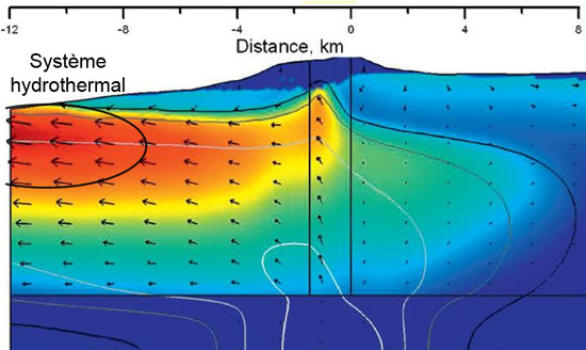
Water and fire coexist under volcanoes to generate “hydrothermal” systems: complex “steam engines” producing white smoke called “fumaroles” that is sometimes observed at the surface. IRD researchers and their partners have just demonstrated why these reservoirs are not always found under the volcanic peaks. For certain structures such as the Ticsani and Ubinas in Peru, where the volcanologists conducted their study, resurgences occur more than 10 km from the top of the dome. Their numerical model shows that the position of the hydrothermal systems depends on regional topography, which may significantly deviate subsurface flows.
Volcanic activity indicators
Most active volcanoes have an internal hydrothermal system, resulting from the infiltration of rainwater, which in contact with the magma, acidifies, heats up, boils and is partly vaporised. Variations in the movement and volume of these liquids or gases reflect changes in volcanic activity. In some eruptions, when magma breaks up in contact with the hydrothermal system, explosive-type eruptions may occur. In the long term, this hydrothermal activity may also contribute to destabilising the volcanic edifice, by altering the rocks. Its position also indicates the permeability of the volcanic rocks. Locating it precisely in the sub-soil helps better estimate the permeability, one of the key parameters of the physical processes at work within volcanoes.
Locating water under the volcano
To understand and better anticipate the unpredictable behaviour of a volcano, it is essential to accurately locate these hydrothermal systems. In fact, they are not necessarily located at the top, as the two Peruvian volcanoes, Ticsani and Ubinas, studied by the research team, demonstrate. Hydrothermal resurgence actually appears more than 10 km downstream from the top of each formation, while only a few events are observed in the hollow of the crater. The researchers firstly measured the soil temperature — up to 37°C at the surface of Ticsani — and hot springs — from 9 to 94°C — as well as the electrical potential created by the movement of fluids in the sub-soil. With this new set of data, they developed a numerical model to explain the asymmetric distribution of hydrothermal fluids.
Major role of the regional landscape
The Ticsani and Ubinas have an atypical profile: peaking at 5,408 and 5,672 metres respectively, they are characterised by a significant difference in altitude between their upstream and downstream sides. Numerical simulations for these two volcanoes show the influence of the regional topography on the position of the hydrothermal system: the considerable altitudinal gradient observed is able to significantly divert the flow of thermal water, shifting groundwater several kilometres in relation to the volcanic cone.
The Ubinas and Ticsani are two of the most active volcanoes in Peru located near the second largest Peruvian agglomeration, Arequipa, which has almost one million inhabitants, and the city of Moquegua. This work helps to locate the water under the volcanoes and to characterise the permanent boiling in their belly. It thus contributes to better monitoring of these threatening giants and better management of eruptive crises.
Note : The above story is based on materials provided by Institut de Recherche pour le Développement (IRD).









